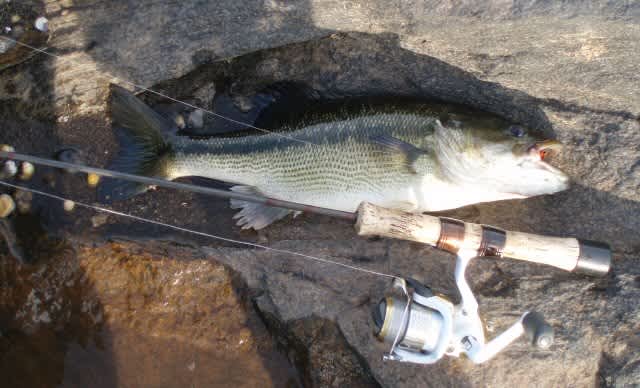Those Darn Spots: Fishing for Late Fall and Winter Spotted Bass
Hank Parker 12.01.11

Nothing can drive a bass fishermen crazy faster than a lake full of spotted bass.
These crafty nomads have a knack of stacking up on structure one day and disappearing the next. Worst yet, they can slam your bait with the velocity of a freight train without getting hooked.
But they’re not all bad. Not only do I enjoy the challenge of fishing for them, but they are a formidable fighter once they are hooked.
Late fall is a good time to fish for them. The spotted bass tend to be more aggressive now and can provide the best action this time of year.
The problem most anglers have is they treat spotted bass like largemouth bass. Spots are a close cousin to the largemouth but they’re habits can be a lot different. Although they look like largemouth, they act more like smallmouth which is why some people call them “southern smallmouth.”
The spot gets its name for the horizontal lines of dark spots on the lower sides, yet at first glance it looks like a largemouth. However, the corner of the spotted bass’ mouth extends only to the back rim of the eye — just like a smallmouth — while the largemouth’s lower jaw protrudes beyond its eye. Also, the spotted bass has a rough spot on its tongue that you won’t find on a largemouth. Spots don’t get as big as largemouth; a three to four pounder is considered large. The world record is 9 pounds, more than half the size of the world record largemouth.
Spotted bass tend to school more and suspend often, which is why they are difficult to locate and catch. The largemouth will burrow right into the thick of cover while spots will linger around it. For example, you may find largemouth in a brush pile and spotted bass suspended over it.
Spots also prefer current more than largemouth, so you’ll find them in or close to moving water. They thrive best in rivers and creeks or reservoirs with moving water.
One of my favorite places to catch them is around bridge pilings where I like to fish soft plastic grubs on 8-pound line and a spinning outfit. If you find the fish schooling around these pilings, you can wear them out. Simply cast upstream with the grub and let the current work it down along the piling. Just don’t count on them being there every day.
But sometimes they’ll fool you. I fished a tournament on Kentucky Lake in October a few years ago and was catching big largemouth in nearby Barkley Lake. However, I wasn’t catching numbers of fish, so I would stop and fish the bridge in the canal between the two lakes and fill out my limit with the grub. I’d always save 10 or 15 minutes so I could stop and catch a few spots. They were there every day and I could have caught 50 of them.
Spots will also hang out under boat docks, especially deep docks on the main lake. Again, a small bait presentation tends to catch them better than a big bait, although they will hit a jig, too.
Crankbaits fished around rocky banks and bridge riprap can be dynamite in the fall, and topwaters like a Zara Spook will draw big spotted bass from water as deep as 15 feet. I’d recommend anglers fish crankbaits and topwaters to help find the schooling spots. After the action slows on those baits, go back through the area with a grub.
If your lake is full of spots and you don’t catch them as well as other anglers, change your tactics to better suit these ornery critters by using smaller baits and fishing around cover instead of directly into it.
There’s no better time to do that than now when the spots are aggressive and eager to help you learn.

